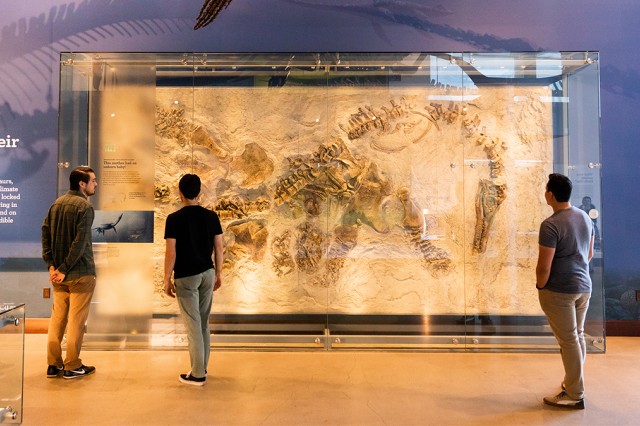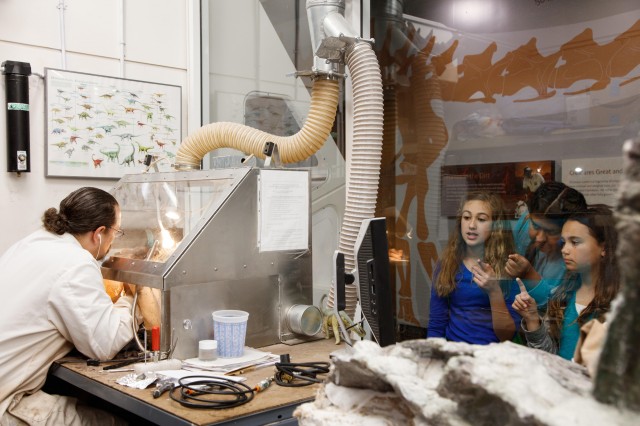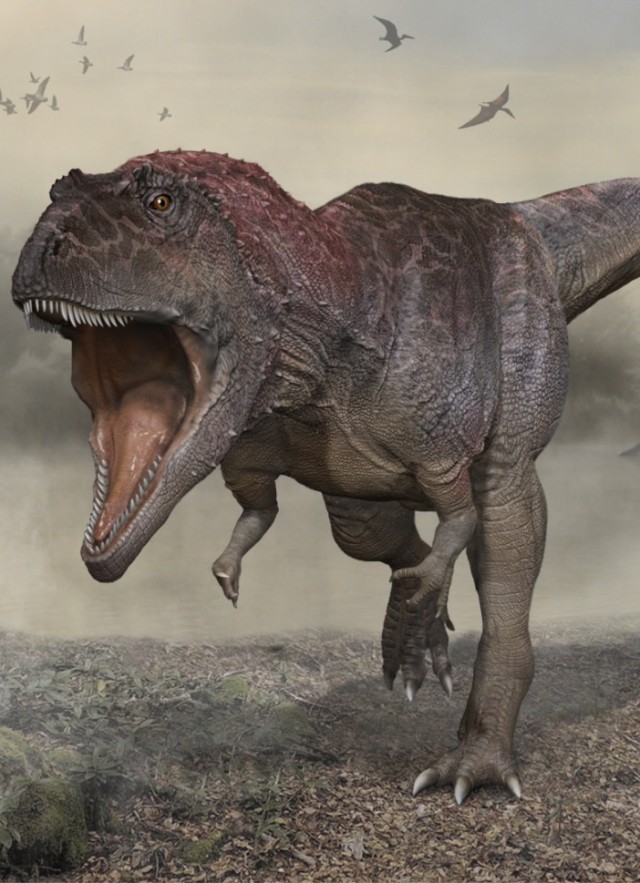
Published August 3, 2023
There’s something new stalking the Cretaceous of Patagonia. Weighing in at more than four tons, it stretched longer than 30 feet from the tip of its tail to its snout at the end of its massive skull. Rugosites–uneven gnarled protrusions–pocked its colossal head, and dagger-sized teeth filled its jaws. Meraxes gigas could fit in any imagined sci-fi/fantasy bestiary, except maybe for its tiny arms.
Named for one of the colossal dragons from George R.R. Martin’s epic Song of Ice and Fire series, the relatively new ancient predator is only one example of the intersection between speculative fiction and science fact. To mangle Jeff Goldblum as Dr. Ian Malcolm: humans make new dinosaur discoveries, new dinosaur discoveries make great movie dinosaurs, great movie dinosaurs make kids want to become paleontologists. By presenting dinosaurs that felt alive, thirty years ago a summer blockbuster breathed new life into paleontology.
“Jurassic Park coming out generated a bunch of interest amongst young people that wanted to become paleontologists and get into the field,” says Dr. Nate Smith, Curator of the Dinosaur Institute at NHM and co-author of the paper describing Meraxes. By some accounts, public interest in paleontology—and new entrants into the field—had waned as the Atomic Age and Space Race following the Second World War fueled excitement for exploring other planets at the expense of our own. Jurassic Park made dinosaurs cool again.
Informed by a resurgence in new dinosaur science in the prior decades, Jurassic Park connected dinosaurs and paleontology to cutting-edge advances like DNA and cloning. Enough of the kids who had their minds blown by smart velociraptors grew up to become paleontologists that they’re commonly referred to as the Jurassic Park generation. There are now more paleontologists than ever hunting for fossils in more locales across the globe.
The boom in paleontologists has led to an explosion in new finds. While many iconic dinosaurs (think Triceratops, Stegosaurus, long-necked sauropods, and duck-billed Hadrosaurus) were initially described in the 1800s, the 21st century is shaping up to be the king of new dinos. Meraxes is one of the roughly 50 new species of dinosaurs described every year, essentially one new dinosaur every week, an astonishingly high number that points to the vibrancy of the field. “We're still rapidly adding a lot more new dinosaur species to the record as we go back and re-describe things, or find new material, or more to the point as we open up whole new areas of geographic and temporal insight into dinosaur evolution,” says Smith.
These young paleontologists have a lot of work to do. It’s estimated that more than 70% of dinosaurs remain undiscovered. Many of those unknown dinos remain to be found and excavated in the field, but others are biding their time in museum collections like NHM’s, waiting for new technology and a better understanding of dinosaur evolution to identify old specimens as new species correctly. If you’re wondering when the flood of new dinosaur species might dry up, Smith notes: “The short answer is, we're not running out yet.” According to Smith, we’re still in the exponential growth portion of the dinosaur discovery curve.
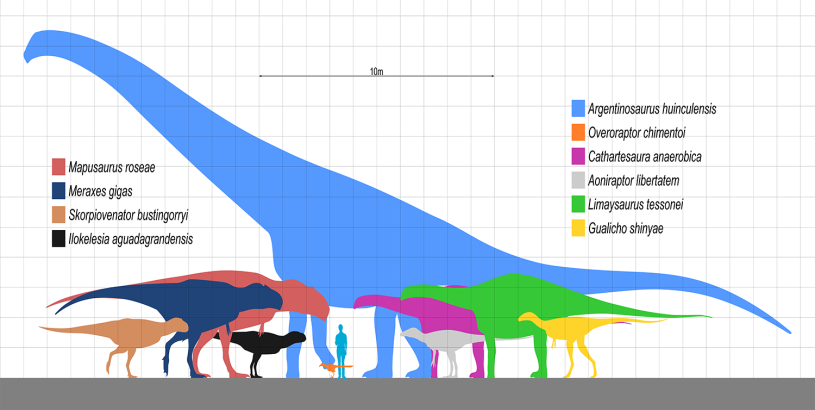
Diagram by Slate Weasel
Dr. Luis Chiappe, Senior Vice President of Research and Collections, and Gretchen Augustyn Director of NHM's Dinosaur Institute, notes another surprising feature of this boom in new species. "While discoveries of new dinosaur species continue unabated, the rate of newly recognized dinosaurs is likely to be especially steep among those of small size. Their fossils are grossly undersampled." Finding more of these smaller species could play a big role in further changing how the public imagines these ancient animals.
Stranger Than Fiction
Laughably little arms paired with giant, lethal heads might seem strange in wholly imagined monsters, but evolution takes paths beyond our imaginations. While Meraxes went extinct almost 20 million years before T. rex stomped into the Cretaceous, the two share similarly small arms.
It’s an example of convergent evolution—where unrelated species develop similar traits. The tiny arms/terrifying head pattern happens again with Carnotaurus, despite all three predators belonging to different families.
Tiny arms are on display in otherwise fearsome therapods in the Dinosaur Hall, like the Carnotaurus pictured above. Despite being distantly related to Meraxes, these hunters evolved tiny arms and large body sizes.
The most iconic giant predator has the most well-known itty bitty arms. The recurrence of big-bodied, small-armed predators is on full display in NHM’s Dinosaur Hall, but exactly what giants like T. rex, Carnotaurus, and Meraxes were doing with them remains a mystery.
1 of 1
Tiny arms are on display in otherwise fearsome therapods in the Dinosaur Hall, like the Carnotaurus pictured above. Despite being distantly related to Meraxes, these hunters evolved tiny arms and large body sizes.
The most iconic giant predator has the most well-known itty bitty arms. The recurrence of big-bodied, small-armed predators is on full display in NHM’s Dinosaur Hall, but exactly what giants like T. rex, Carnotaurus, and Meraxes were doing with them remains a mystery.
“The other contribution has been a ton of new discoveries in both Argentina and Brazil on some of the earliest dinosaurs that in some respects have kind of muddied the waters of what's going on at the base of the dinosaur tree, but also filled in a lot more of our knowledge about how dinosaurs got their start and where they came from,” says Smith. “Thinking in terms of South America in dinosaur evolution, you could consider this golden age as filling in the book ends of the beginning and the end of dinosaur evolution.”
Flock This Way
If you grew up with Jurassic Park, it might be hard to identify the tale-dragging, cold-blooded, slow-witted, brutes previously depicted in film. Their giant size and relegation to the ancient past meant they were mostly translated into monsters—terrifying, but ultimately evolutionary dead ends. Jurassic Park converted monsters into animals inhabiting the planet alongside human characters (when not hunting them down).
The warm-blooded, intelligent animals stalking Jurassic Park were made plausible by a suite of scientific research from the previous decades that upturned widely-held assumptions about dinosaurs that dominated the scientific understanding of dinosaurs for most of the previous century. While Spielberg and company brought these new understandings to the big screen, they were building on the bones of what’s now known as the Dinosaur Renaissance.
Finding birdier dinosaurs like Deinonychus antirrhopus by paleontologists like John Ostrom helped solidify the understanding that birds are dinosaurs, while new methods in paleobiology helped redefine dinosaurs as likely warm-blooded, active animals. Robert T. Bakker’s 1986 book The Dinosaur Heresies laid out the arguments for dinosaurs being bird-like beasts, directly inspiring their depictions in the film and even getting name-dropped. New methods and tools for accurately inferring evolutionary relationships in the 1980s also bolstered the evidence for a dinosaurian ancestry of birds. While Jurassic Park didn’t get everything right, the dynamic animals in the film reflected a culmination of new dinosaur research. Even though dinosaur DNA is almost certainly never going to be found, the generation of researchers inspired by the premise continues expanding our view of dinosaurs in ways once thought to be impossible.
“I never would've predicted understanding coloration and fossils by looking at shapes and sizes and patterns of melanosomes and really exceptionally preserved feathers,” says Smith. Dino DNA may be out of reach, but melanosomes—tiny organelles preserved with dinosaur feathers—are bringing part of their color back to life. Researchers found that their shapes could be translated into colors, revealing the prehistoric palette of dinosaurs for the first time. “20 years ago, if you had asked me, I would've probably said: "We can make some inferences and things like that, but no, we're probably not going to ever know what kind of color patterns there were."
It’s just one of a previously unthinkable host of discoveries happening right now as the generation of researchers inspired by the sci-fi classic continues to unearth new dinosaur species and specifics. From the first detailed look at a dinosaur butthole in 2021 (ok, it’s a cloaca) to the pervasiveness of feathers among dinosaurs, paleontologists are constantly re-sculpting our conception of these animals entombed in rock, and those new findings often make their way into the next iteration of on-screen dinos. Jurassic World: Dominion featured Giganotosaurus, similarly Argentinian and one of the biggest known carnivores on land, and a member of the same family as Meraxes, along with the first feathered raptor—the still overly-large Pyroraptor.
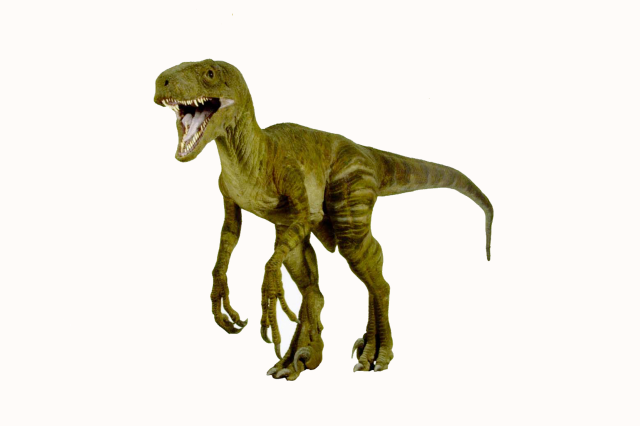
While emphasizing the bird-brained abilities of one of its break-out stars, the film depicted an overly-large Velociraptor for dramatic effect. The terrifying intelligence of Velociraptors highlighted a departure from dinosaurs as dim-witted beasts. Fierce but featherless, the model from Jurassic Park will be on display during Dino Fest at NHM.
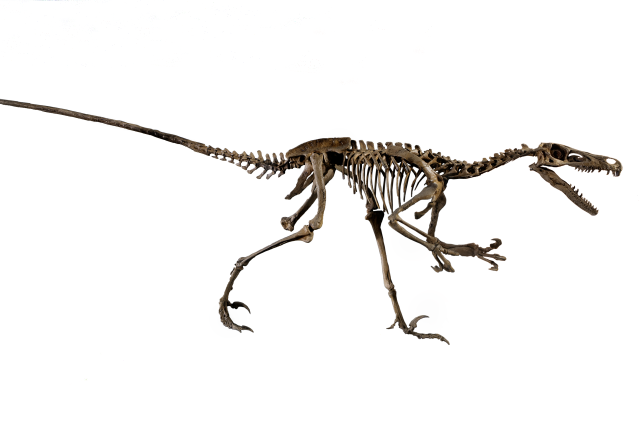
While this year marks the 30th anniversary of the first Jurassic Park, it's the 100th anniversary of the real Velociraptor's discovery. The turkey-sized dinosaur was found in the Gobi Desert, and its birdy body is on display in NHM's Dinosaur Hall every day of the week. Our understanding of these animals is drastically different from the film's depiction—their claws were likely used for stabbing and there's little evidence of pack hunting.
1 of 1
While emphasizing the bird-brained abilities of one of its break-out stars, the film depicted an overly-large Velociraptor for dramatic effect. The terrifying intelligence of Velociraptors highlighted a departure from dinosaurs as dim-witted beasts. Fierce but featherless, the model from Jurassic Park will be on display during Dino Fest at NHM.
While this year marks the 30th anniversary of the first Jurassic Park, it's the 100th anniversary of the real Velociraptor's discovery. The turkey-sized dinosaur was found in the Gobi Desert, and its birdy body is on display in NHM's Dinosaur Hall every day of the week. Our understanding of these animals is drastically different from the film's depiction—their claws were likely used for stabbing and there's little evidence of pack hunting.
More than making a bigger monster, new research from the Age of Dinosaurs can inform our understanding of our present. Smith says that things like paleo molecules and other chemical signatures found in fossilized bones and eggshells promise to reveal even more about the ecology and biology of dinosaurs and their world, begging the question: “How can we use this knowledge of how life reacted to certain climatic changes or external factors to understand the current biodiversity crisis we're in?”
"While all these discoveries are revealing a tremendous wealth of information about the lives of dinosaurs, they are also fueling numerous new questions that in turn require more discoveries to be answered," says Chiappe. “This duet between new discoveries and new questions will keep generations of paleontologists very busy for many years to come."
We can’t say what the next huge breakthrough or mind-blowing new species will be, but we can be sure they are coming. Whether buried in the Earth or deep inside museum collections, new revelations about dinosaurs and their lost world are already waiting with the next shocking twist or maybe even a rewrite. Only time—and paleontologists—will tell. One thing is certain: the future of dinosaur paleontology promises to be a wild ride, so hold onto your butts.
